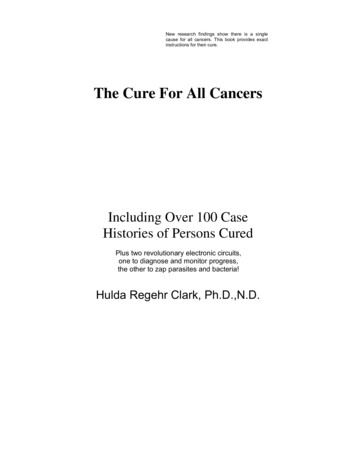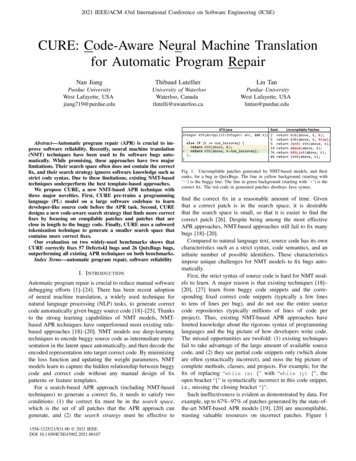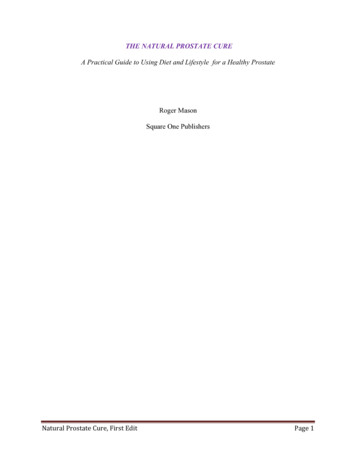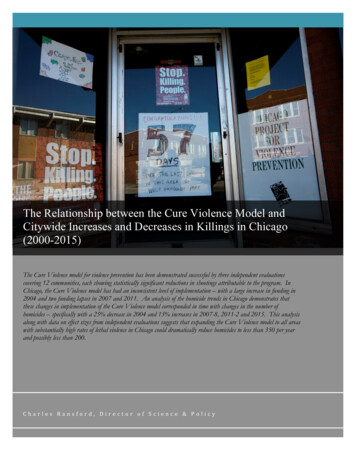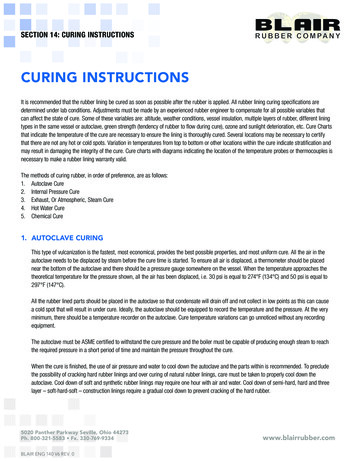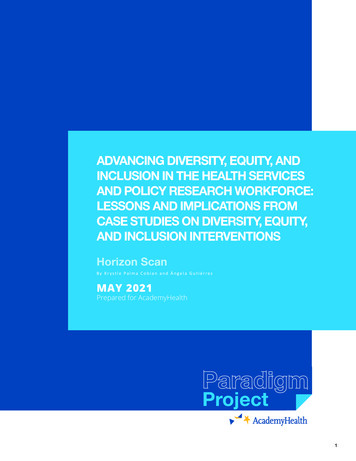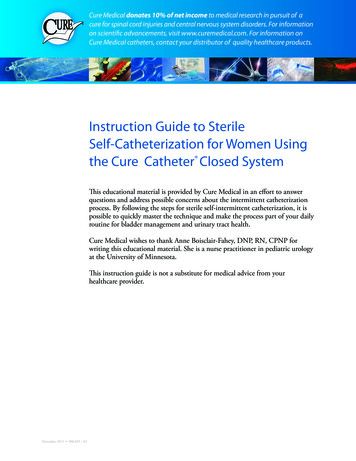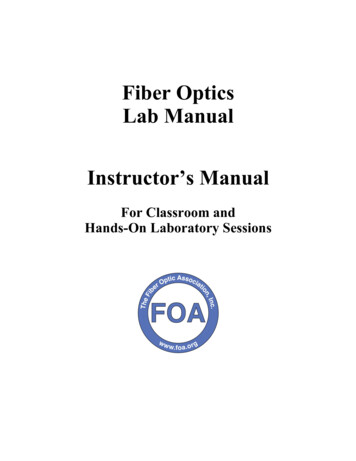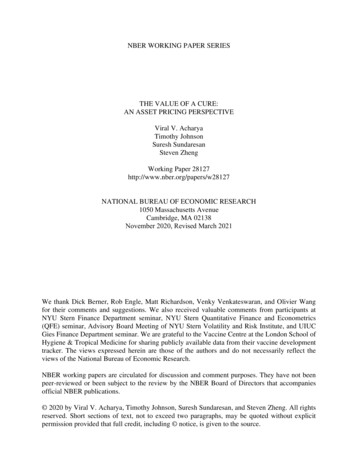
Transcription
NBER WORKING PAPER SERIESTHE VALUE OF A CURE:AN ASSET PRICING PERSPECTIVEViral V. AcharyaTimothy JohnsonSuresh SundaresanSteven ZhengWorking Paper 28127http://www.nber.org/papers/w28127NATIONAL BUREAU OF ECONOMIC RESEARCH1050 Massachusetts AvenueCambridge, MA 02138November 2020, Revised March 2021We thank Dick Berner, Rob Engle, Matt Richardson, Venky Venkateswaran, and Olivier Wangfor their comments and suggestions. We also received valuable comments from participants atNYU Stern Finance Department seminar, NYU Stern Quantitative Finance and Econometrics(QFE) seminar, Advisory Board Meeting of NYU Stern Volatility and Risk Institute, and UIUCGies Finance Department seminar. We are grateful to the Vaccine Centre at the London School ofHygiene & Tropical Medicine for sharing publicly available data from their vaccine developmenttracker. The views expressed herein are those of the authors and do not necessarily reflect theviews of the National Bureau of Economic Research.NBER working papers are circulated for discussion and comment purposes. They have not beenpeer-reviewed or been subject to the review by the NBER Board of Directors that accompaniesofficial NBER publications. 2020 by Viral V. Acharya, Timothy Johnson, Suresh Sundaresan, and Steven Zheng. All rightsreserved. Short sections of text, not to exceed two paragraphs, may be quoted without explicitpermission provided that full credit, including notice, is given to the source.
The Value of a Cure: An Asset Pricing PerspectiveViral V. Acharya, Timothy Johnson, Suresh Sundaresan, and Steven ZhengNBER Working Paper No. 28127November 2020, Revised March 2021JEL No. D5,G12,I1,Q54ABSTRACTWe provide an estimate of the value of a cure using the joint behavior of stock prices and avaccine progress indicator during the ongoing COVID-19 pandemic. Our indicator is based onthe chronology of stage-by-stage progress of individual vaccines and related news. We constructa general equilibrium regime-switching model of repeated pandemics and stages of vaccineprogress wherein the representative agent withdraws labor and alters consumption endogenouslyto mitigate health risk. The value of a cure in the resulting asset-pricing framework is intimatelylinked to the relative labor supply across states. The observed stock market response to vaccineprogress serves to identify this quantity, allowing us to use the model to estimate the economywide welfare gain that would be attributable to a cure. In our estimation, and with standardpreference parameters, the value of the ability to end the pandemic is worth 5-15% of totalwealth. This value rises substantially when there is uncertainty about the frequency and durationof pandemics. Agents place almost as much value on the ability to resolve the uncertainty as theydo on the value of the cure itself. This effect is stronger – not weaker – when agents have apreference for later resolution of uncertainty. The policy implication is that understanding thefundamental biological and social determinants of future pandemics may be as important asresolving the immediate crisis.Viral V. AcharyaStern School of BusinessNew York University44 West 4th Street, Suite 9-65New York, NY 10012and CEPRand also NBERvacharya@stern.nyu.eduTimothy JohnsonCollege of BusinessUniversity of Illinois343E Wohlers Hall1206 South Sixth StreetChampaign, IL 61820tcj@illinois.eduSuresh SundaresanColumbia Business School3022 BroadwayNew York, NY 10027ms122@columbia.eduSteven ZhengStern School of BusinessNew York University44 West 4th StreetNew York, NY 10012steven.zheng@stern.nyu.eduA data appendix is available at http://www.nber.org/data-appendix/w28127
1IntroductionQuantifying the scale of the economic damage caused by a pandemic is a crucial step in assessing policy responses along social, medical, fiscal, and monetary dimensions. This paper buildson the hypothesis that stock markets may contain valuable information for gauging the value ofending the pandemic. Stock markets, which corrected by as much as 40-50% at the outbreak ofthe coronavirus pandemic in February-March 2020, have rebounded robustly within six months.While there are many explanations proposed for the seeming disconnect between the real economy ravaged by the pandemic and the buoyant stock market, one candidate on the table relatesto the progress in development of vaccines1 to end the pandemic. On the one hand, only the arrival (and delivery) of an efficacious vaccine is considered as a definitive event that will end thepandemic and result in robust economic recovery.2 On the other hand, stock prices – by reflecting forward-looking expectations – should reflect the economic value of credible progress in thedevelopment of vaccines; this value arises from the ability of vaccines to end the pandemic and isnaturally related to the scale of the economic damage caused by the pandemic.The relationship between stock prices and vaccine development is well-illustrated by the following examples. On May 18 and July 14, 2020, Moderna, one of the vaccine developing companies, announced good news relating to the progress in its Phase I clinical trials and moving to thenext stage of trials. Similarly, on November 9, 2020, Pfizer and BioNTech announced positive newsregarding their Phase III clinical trials. In response to these news, the U.S. stocks gained over 1trillion in cumulative market capitalization over these three days, with several pandemic-exposedsectors such as airlines, cruise ships, and hotels experiencing 10-20% appreciations on each day.These moves were both economically large and indicative of time to deployment of a vaccinebeing an important factor driving variation in stock market prices.3We build upon these observations and offer an asset-pricing perspective to estimate the valueof a cure, i.e., the amount of wealth that a representative agent would be willing to pay for obtaining a vaccine that puts an end to the pandemic. While there are now several estimations in1 Weuse “cure" and “vaccine" interchangeably to denote something that brings the pandemic to an end, despite beingmedically very different.2 See Lauren Fedor and James Politi, Financial Times, May 18, 2020 in the Appendix.3 See (1) Matt Levine, Money Stuff, May 19, 2020, (2) Matt Levine, Money Stuff, July 16, 2020, (3) John Authers,Bloomberg Opinion, November 10, 2020, and (4) Laurence Fletcher and Robin Wigglesworth, Financial Times, November 14, 2020 in the Appendix.1
the literature of how costly the pandemic is to the economy, our approach is different in that ituses stock market data to calculate the ex-ante value of a cure. Our approach is directly analogousto the seminal work of Lucas (1987) in assessing the welfare costs associated with business cyclerisk. Just as that paper provides a framework for assessing the consequences of policy responsesto mitigate output volatility, our work speaks to the cost-benefit analysis of potential public sectorinvestment in alleviating the threat of current and future pandemics. Going beyond our baselineestimate for the value of a cure, we can also shed light on which of the primitive elements of theeconomy are driving that value.Our analysis proceeds as follows.First, we document empirically the joint behavior of stock returns (for market portfolio andcross-section of industries) and expected time to deployment of a vaccine. To this end, we construct a novel “vaccine progress indicator." Our indicator is based on the chronology of stage-bystage progress of individual vaccines (obtained from the Vaccine Centre at the London School ofHygiene & Tropical Medicine) and related news (obtained from FactSet). Using data on vaccinedevelopment for past epidemics and surveys during the COVID-19 pandemic, we calibrate theprobabilities of transition across different stages of vaccine development and use news to “tap"these probabilities up or down. We then simulate over 200 vaccine “trials" corresponding to thevaccines being developed, factoring in a correlation structure between trials based on relevantcharacteristics such as their approach (“platform"), belonging to a common company, etc. The result of this exercise is a vaccine progress indicator using all available information at a given pointof time expressed in terms of expected time to deployment of a vaccine.4 The evolution of ourindicator is shown in Figure 1.We then relate stock market returns to changes in the expected time to deployment of a vaccineby regressing the returns on changes in our vaccine progress indicator, controlling for laggedreturns as well as large moves attributable to release of other macroeconomic news. Allowingfor some lead-lag structure in the relationship, e.g., due to leakage of news or dating noise in ournews data, we estimate that a reduction in the expected time to deployment of a vaccine by a yearresults in an increase in the stock market return as a whole by between 4 to 8% on a daily basis.4 Ananalogy from credit risk literature is that of a first-to-default basket in which several correlated firms are part of abasket and the quantity of interest is the expected time to a first default.2
The joint relationship exhibits the anticipated cross-sectional properties, with the co-movementbetween returns and changes in the vaccine progress indicator being stronger for sectors mostaffected by the COVID-19 pandemic (see Figure 4).Second, we build a general equilibrium regime-switching model of pandemics with asset pricing implications to translate this empirical co-movement of stock returns and vaccine progressindicator into the value of a cure. We consider an economy with a representative agent who hasstochastic differential utility (Epstein-Zin preferences) with endogenous labor and consumptionchoices. The state of the economy can be “normal," i.e., without a pandemic, or in a pandemic;within the pandemic, there are several regimes mapping into the stages of vaccine development.The economy transitions across these states based on a set of stationary probabilities. Once theeconomy switches out of a pandemic, another pandemic may occur in future. Labor augmentsagent’s capital stock that can be readily converted into consumption; however, labor exposes theagent to the pandemic in that within the pandemic regime, the agent can be hit by a health shockthat destroys forever a part of the agent’s capital stock, and this likelihood is proportional to thelabor supply.5 A key feature of the model is that the agent withdraws labor in the pandemic statesin order to mitigate the economic exposure to a health shock. In other words, the arrival of a pandemic and the incidence of a health shock for the agent within the pandemic can be considered as“rare disasters”, the exposure to which is partly controlled by the agent.Third, we characterize the solution to the agent’s problem of choosing labor and consumption in each state of the economy and derive the respective objective function values, which areinter-dependent but are amenable to a straightforward numerical solution of a fixed-point problem. We can then examine the pricing kernel and asset prices in this framework; in particular,we evaluate the value of a claim to future output, and study its relationship with the expectedtime to switching out of a pandemic state. This provides a theoretical counterpart to our empiricalestimate of co-movement between stock market return and changes in vaccine progress indicator.A principal insight of our asset-pricing perspective is the following: the improvement in the welfare of the agent in switching out of a pandemic is related to the extent of contraction in labor in5 Thepermanent loss of capital stock can be due to a variety of factors such as loss of life, reduced productivity orattrition of human capital in working from home amidst closures of schools and lack of child care support, filing ofbankruptcies with deadweight losses in asset value, and firing of labor with difficulty in re-matching to available jobsat a future date.3
the pandemic state relative to the non-pandemic one; this same labor contraction is an importantstatistic (modulated by preference and pandemic parameters) that determines how sensitive arestock prices to progress towards deployment of a vaccine. The model delivers the implication thatthe value of moving from a pandemic state to a non-pandemic state is simply the ratio of marginalpropensity to consume in the pandemic state to that in the non-pandemic state, augmented by theintertemporal elasticity of substitution. Thus, the desire to resolve uncertainty sooner is informedby the endogenous consumption choices made by the household in pandemic states.We can therefore readily connect our empirical work to the theoretical asset-pricing perspective. With standard preference parameters employed in the literature, the value of a cure turns outto be worth 5-15% of wealth (formally, capital stock in our model). At our baseline assumptionsfor other parameters, this corresponds to an approximately 25% contraction of labor during thepandemic relative to the non-pandemic state. The reason why the economy would attach such alarge value to the vaccine is because the pandemic causes a permanent loss of capital stock whenit effects agents, which in turn is reflected in the significant precautionary contraction of laborduring the pandemic. In spite of the simplicity of our model of the pandemic, we can readilyexamine externalities in the setup. Specifically, the representative agent can impose through itslabor choice exposure for all other agents in the economy, but not internalize this spillover; weexamine the difference in the value of a cure with a precautionary labor choice being made bythe representative agent versus that by the central planner. Since the planner contracts the labormore and optimally reduces pandemic exposure for the economy as a whole, the planner attachesa lower value to the cure than the representative agent does.6Finally, our estimate of the value of a cure depends crucially on the frequency and the expected duration of the pandemic, which raises the natural question of parameter uncertaintyaround these pandemic properties. Such uncertainty is natural given the rare nature of such pandemics and the evolving understanding of connections between various pandemics (SARS, H1N1,COVID-19, etc.).7 The final exercise we undertake is to assess the effect of imperfect information6 Note,however, that the planner may attach a higher value to the cure if the arrival of the pandemic were to result insocial costs outside the capital stock dynamics for the agent.7 See, for example, “COVID-19 Is Bad. But It May Not Be the ’Big One’", Maryn McKenna, Wired, June 17, 2020,“Coronavirus Response Shows the World Is Not Ready for Climate-Induced Pandemics", Jennifer Zhang, ColumbiaUniversity Earth Institute, February 24, 2020, and “The next pandemic: where is it coming from and how do we stopit?", Leslie Hook, Financial Times, October 29, 2020.4
on the value of a cure.We specialize our framework to just two states, non-pandemic and pandemic (without individual stages of vaccine development), but allow for uncertainty about frequency and duration ofpandemics. The agent learns about these parameters as pandemics arrive and end. We can extendour asset-pricing framework also to this setting with uncertainty and learning. It turns out thatthe value of the cure rises sharply when there is uncertainty about the frequency and duration ofpandemics. Indeed, we find that the representative agent would be willing to pay as much for resolution of this parameter uncertainty as for the cure absent such uncertainty. This effect is stronger– not weaker – when agents have a preference for later resolution of uncertainty (formally, an elasticity of intertemporal substitution, or EIS, which is lower than the inverse coefficient of relativerisk aversion) as this induces a more significant contraction of labor during pandemics. An important policy implication is that understanding the fundamental biological and social determinantsof future pandemics, for instance, whether pandemics are related to zoonotic diseases triggeredmore frequently by climate change, may be as important to mitigating their economic impact asresolving the immediate pandemic-induced crisis.A few caveats are in order. Our model of pandemics is close to that of rare disasters in assetpricing literature (Barro, 2006; Gabaix, 2012; Tsai and Wachter, 2015) but with endogenous exposure of the agent to disasters as well as featuring endogenous consumption, labor and assetprices. However, we do not feature SIR-style dynamics of an individual pandemic itself. Finally,our model also does not feature the impact of economic-stabilization policies such as fiscal ormonetary support; however, we do control for the announcement effect of such policies in ourempirical work.The rest of the paper is organized as follows. Section 2 relates to the existing literature. Section 3describes the construction of vaccine progress indicator and estimates of its covariance with stockmarket returns. Section 4 presents our general equilibrium regime-switching model of pandemicswith endogenous labor and consumption decisions, and derives asset prices in this frameworkthat help estimate the value of a cure for the pandemic. Section 5 extends (two-state version of)the model to allow for parameter uncertainty and learning to study the impact on the value of acure from such uncertainty and the value attached to resolving it. Section 6 concludes with some5
further directions for research. All proofs not in the main text are contained in the Appendix.2Related LiteratureAs noted in the introduction, our approach to quantifying the cost of the pandemic parallels thatof Lucas (1987) in assessing the cost of business cycles. While Lucas (1987) finds small welfareimprovements to reducing this risk, Tallarini Jr (2000) shows that this conclusion is overturnedin models with recursive utility when calibrated to match asset pricing moments. Echoing thisfinding and foreshadowing our own, Barro (2009) reports that, in a model with rare disasters,moderate risk aversion, and an elasticity of intertemporal substitution greater than one, societywould willingly pay up to 20% of permanent income to eliminate disaster risk.A number of papers have modeled climate risk using the approach that long-run risk of climate risk can manifest itself through Poisson shocks to the capital stock, which is the approach weare pursuing here in the context of pandemics. A detailed survey of this literature is provided byTsai and Wachter (2015) for better understanding asset pricing puzzles. A number of papers, including Pindyck and Wang (2013), explore the welfare costs associated with climate risk. The latterwork addresses the issue of how much should society be willing to pay to reduce the probabilityor impact of a catastrophe.While the literature studying the economic impact of COVID-19 has exploded in a short period of time, there is relatively little focus on the role played by vaccine development and itsprogress. We first relate to the theoretical literature in asset pricing that is closest to our model; wethen relate to the empirical literature on observed contraction in employment and consumptionduring the pandemic.Hong et al. (2020b) study the effect of pandemics on firm valuation by embedding an assetpricing framework with disease dynamics and a stochastic transmission rate, equipping firmswith pandemic mitigation technologies. Similar to our paper, they model vaccine arrival as aPoisson jump process between pandemic and non-pandemic states. Hong et al. (2020a) combinethe model of Hong et al. (2020b) with pre- and post-COVID-19 analyst forecasts to infer marketexpectations regarding the arrival rate of an effective vaccine and to estimate the direct effect ofinfections on growth rates of earnings. In particular, they develop a regime-switching model ofsector-level earnings with shifts in their first and second moments across regimes.6
In both of these papers, the pricing kernel is exogenously specified for the pandemic and thenon-pandemic states. In contrast, our model is general equilibrium in nature with the representative agent optimally choosing labor and consumption (and, in turn, investment in capital) tomitigate health risk. Deriving asset prices from first principles in a regime-switching frameworkof pandemics – which allows for several sub-states in a pandemic relating to vaccine progress – isan important theoretical contribution of our paper. We build upon this setup further to introducelearning when there is parameter uncertainty about pandemic parameters.8For empirical work, Hong et al. (2020b) fix expected pandemic duration around one year butshow in comparative statics that asset prices show considerable sensitivity to the arrival rate ofthe vaccine. Hong et al. (2020a) use their model to infer the arrival rate of the vaccine. In contrast,we provide a “vaccine progress indicator" in the form of an estimated time to vaccine deploymentusing actual data and related news on the progress of clinical trials of vaccines for COVID-19.We relate this vaccine progress indicator to stock market returns to infer labor contraction in thepandemic relative to the non-pandemic state.Elenev et al. (2020) incorporate a pandemic state with low but disperse firm productivity thatrecurs with low probability for studying government intervention in corporate credit markets.While we do not model credit markets in our setup, our differentiating novel features are: construction of a vaccine progress indicator and estimation of its joint relationship with stock markets,and mapping it into a general equilibrium regime-switching model of pandemics with asset pricesin order to derive an estimate of the value of a cure.Kozlowski et al. (2020) model learning effects that lead to long-term scarring after the pandemic is over as policy responses relating to debt forgiveness in the current pandemic can lead tolower leverage and consumption in the post-pandemic era. Through the learning channel in ourmodel, there can also be “scarring" effects wherein agent’s consumption upon exit from a pandemic does not revert to the pre-pandemic levels due to the increase in updated probability offuture pandemics. This, however, is not the focus of our paper.Collin-Dufresne et al. (2016) show that learning can amplify the pricing of macroeconomicshocks when the representative agent has Epstein-Zin preferences and Bayesian updating. Our8 Ona technical front, Hong et al. (2020b,a) consider aggregate transmission risk into SIR-style model, whereas ourmodel of health risk arising from a pandemic is closer to the literature on rare disasters cited in the Introduction.7
results on learning and the impact of parameter uncertainty on the value of a cure are related tothe findings of both these papers; our model can generate both long-term scarring in consumptiondue to updated probability of pandemics and significant contraction of labor and consumptionwhen parameter uncertainty is high, when the elasticity of intertemporal substitution (EIS) is low.Interestingly, expected time to deployment of a vaccine can be considered as a “macroeconomicshock" in our model that affects asset prices and depends crucially on parameter uncertainty in amanner that interacts with deep preference parameters.3Vaccine Progress Indicator and its Covariance with Stock ReturnsAs described in the introduction, the paper’s hypothesis is that the stock market may conveyimportant information about the social value of resolving the pandemic. This section explainshow we attempt to extract that information. There are two distinct steps. First, we construct amethod for summarizing the state of vaccine research throughout 2020. Second, we estimate thestock market response to its changes.3.1Measuring Vaccine ProgressReaders are, by now, broadly familiar with the contours of the global effort to develop a vaccine forCOVID-19. Through many of the excellent tracker apps, dashboards, and periodic survey articleswe were all educated about the dozens of candidates under study, and their progress throughpre-clinical work and clinical trials. On any given day, the state of the entire enterprise is a highdimensional object consisting of multiple pieces of information about all of the projects. Our goalis to reduce that high dimensional object to a single number. Also, crucially, the number shouldhave a tangible physical (or biological or economic) interpretation.The single most salient aspect of vaccine development, the number that nearly all discussionsboiled down to, was the anticipated time until widespread availability of a proven candidate. Wetherefore construct estimators of that quantity, using information that was available to observersat the time.To do this, we introduce a stochastic model of candidate progress. We obtain the pre-clinicaldates and trial history of vaccine candidates from publicly available data collated by the LondonSchool of Hygiene & Tropical Medicine (LSHTM). The model necessarily involves many param-8
eters for which we have little hope of obtaining precise estimates. Details of our choices of allparameters are explained in Appendix B. We will validate our choices both by examining robustness to reasonable variation and by comparing them to other actual ex ante forecasts publishedduring the sample period.9Our stochastic model is a means to simulate, on each day t, the ultimate outcome of each of thecandidates given their state of development as of that day. That simulated outcome, for candidaten {1, . . . , N }, is either reaching deployment by some date Tn t or not in which case Tn .Using the model, we can then run a large number, M, of joint simulations as of day t encompassingall of the candidates. In each simulation, m, the earliest time to widespread deployment is Tm? minn { Tn }. The cross-simulation average value of Tm? is the model’s expectation TtD for thetime to widespread deployment, conditional on at least one of the active candidates reachingdeployment. Some fraction, µ, of simulations will result in all candidates failing and not reachingdeployment. Our forecast is the full expectation, Et T ? defined as (1 µ) TtD µT ND , where T NDis an estimate of the time to deployment by a project other than those that are currently active(i.e., conditional on all active candidates not reaching deployment).10 In addition to the mean, themodel also delivers the full distribution, and hence all quantiles, of T ? as of each date.The model starts with a standard partition of the clinical trial sequences between pre-clinical,Phases I, II, III, application submission, and approval stages. A candidate in each stage eithersucceeds and moves to the next stage or fails.11 We append a final stage: deployment, which anapproved vaccine possibly still could not attain, e.g., due to technical infeasibility or emergenceof serious safety concerns. Our assumption is that each stage is characterized by an unconditionalprobability of success, πs , and an expected duration, τs .12 We model each stage transition as a2-state Markov chain with exponentially distributed times. Specifically, if we define two exponen9 The appendix also presents evidence that our distributional assumptions are reasonably consistent with the (small) setof observed trial outcomes.model does not attempt to forecast the entry of new projects.11 This is a simplification. Candidate vaccines will actually undergo multiple overlapping trial sequences with differentpatient populations, delivery modalities, or medical objectives (endpoints). One sequence could fail while otherssucceed. Trials can also combine phases I and II or II and III. In our empirical implementation we focus on the mostadvanced trial of a candidate. This follows Wong et al. (2018).12 Our success probabilities are taken from pharmaceutical research firm BioMedTracker and are based upon historicaloutcomes of infectious disease drug trials. Our duration estimates are based on projections from the pharmaceuticaland financial press during 2020. See Appendix A for several examples.10 The9
tially distributed random variables tu and td with intensitiesλus πsτsandλds 1 πsτs(1)then it is straightforward to show that ts min{tu , td } is exponentially distributed with intensity1/τs and that the probability of success, defined as tu td , is πs .Since our objective is to model the joint outcomes of all the vaccine projects, we need to specify the joint distribution of successes and failures. We do this by assuming the exponential times{tun }nN 1 are generated by a Gaussian copula with correlation matrix R, and likewise for the times{tdn }. The elements of the correlation matrix are set to positive values to capture the dependencebetween candidates. This positive dependence arises most obviously because all the vaccinesare targeting the same pathogen, and will succeed or fail largely due to its inherent biologicalstrengths and weaknesses. Beyond that, we also capture the dependence of candidates on one ofa handful of strategies (or platforms) for stimulating immunological response. If, for example, anRNA-based platform proves to be safe and effective, then all candidates in this family would havea higher likelihood of success.13 Finally, some research teams (institutes or companies) have several candidate vaccines. Positive correlation between their outcomes may arise through relianceon common technological components, resources, or abilities.As described so far, the “state” of a candidate is simply its current clinical-trial phase. Thisis not realistic in the sense that initiation of a new phase, as captured by the commencement of anew stage trial, is often known in advance. The trial start date (as reported to the U.S. govern
The relationship between stock prices and vaccine development is well-illustrated by the fol-lowing examples. On May 18 and July 14, 2020, Moderna, one of the vaccine developing compa- . of a cure, i.e., the amount of wealth that a representative agent would be willing to pay for ob-



